Blog
DIY Hair Masks: The Ultimate Guide to Natural Hair Care
Taking care of your hair naturally has never been more important. Modern-day stressors like pollution, styling tools, and chemical-laden products can leave our hair dull and lifeless. But here’s the good news: you don’t need fancy products or costly salon treatments to bring your hair back to life. I’ve tried countless DIY hair masks, and trust me, the right ingredients from your kitchen can work wonders.
In this guide, I’ll walk you through everything you need to know about creating effective, easy, and affordable DIY hair masks tailored to your needs. Let’s dive in!
Why DIY Hair Masks Are a Game Changer
Homemade hair masks have multiple benefits, and here’s why they stand out:
- Control over ingredients: No hidden chemicals—just pure, natural goodness.
- Cost-effective solutions: You can pamper your hair without breaking the bank.
- Customizable recipes: Address specific hair concerns with targeted ingredients.

| Key Benefits of DIY Hair Masks | Why It Matters |
|---|---|
| Nourishes hair with natural ingredients | Avoids damage caused by harsh chemicals |
| Tailored for your unique hair needs | Customize recipes for oily, dry, or damaged hair |
| Saves money | Reduces the need for expensive salon treatments |
| Environmentally friendly | Cuts down on waste from packaged hair products |
Understanding Your Hair Needs
Before diving into recipes, it’s essential to understand your hair type and concerns. Identifying your specific needs ensures the mask will work effectively.
| Hair Concern | Recommended Ingredients |
|---|---|
| Dry or damaged hair | Coconut oil, avocado, honey |
| Oily hair | Yogurt, lemon juice, apple cider vinegar |
| Dandruff or itchy scalp | Tea tree oil, aloe vera, neem powder |
| Hair thinning or loss | Castor oil, rosemary essential oil, egg |
Best DIY Hair Masks for Every Hair Type
For Dry and Damaged Hair
Coconut Oil and Honey Mask
This mask is my personal favorite for repairing dry and brittle hair.
- Ingredients:
- 2 tablespoons of coconut oil
- 1 tablespoon of honey
- Steps:
- Mix the coconut oil and honey until smooth.
- Apply evenly from roots to ends.
- Leave on for 30 minutes before rinsing.
- Why it works: Coconut oil penetrates deep into the hair shaft, while honey locks in moisture.

For Oily Hair
Yogurt and Lemon Juice Mask
On days when my scalp feels greasy, this mask works wonders.
- Ingredients:
- 2 tablespoons plain yogurt
- 1 tablespoon lemon juice
- Steps:
- Combine yogurt and lemon juice.
- Massage onto your scalp.
- Leave for 20 minutes before rinsing thoroughly.
- Why it works: Yogurt cleanses the scalp while lemon juice balances oil production.
For Dandruff Relief
Aloe Vera and Tea Tree Oil Mask
Nothing soothes an itchy scalp like aloe vera.
- Ingredients:
- 2 tablespoons aloe vera gel
- 3 drops tea tree oil
- Steps:
- Mix aloe vera gel and tea tree oil.
- Apply to your scalp, focusing on problem areas.
- Leave for 30 minutes before rinsing.
- Why it works: Aloe vera moisturizes and tea tree oil fights dandruff-causing bacteria.

For Hair Growth
Castor Oil and Rosemary Mask
This mask has been a game-changer for my hairline.
- Ingredients:
- 2 tablespoons castor oil
- 5 drops rosemary essential oil
- Steps:
- Mix the oils and massage into your scalp for 5 minutes.
- Leave on for at least 1 hour before shampooing.
- Why it works: Castor oil strengthens roots, while rosemary oil stimulates blood flow.
How to Apply Hair Masks Effectively
Using the right application technique is key to maximizing the benefits of DIY masks:
- Start with clean hair: Wash your hair lightly before applying the mask.
- Apply evenly: Use your fingers or a brush to spread the mask from roots to tips.
- Cover for better absorption: Wrap your hair in a shower cap or towel to trap heat.
- Rinse thoroughly: Use lukewarm water, followed by a gentle shampoo.
FAQs
1. Can these masks be used on color-treated hair?
Yes, but avoid ingredients like lemon juice, which can fade color. Opt for coconut oil or avocado-based masks.
2. How often should I use a hair mask?
Use once a week for normal maintenance. For damaged hair, try twice a week.
3. How can I remove oily masks easily?
Massage shampoo into dry hair first, then rinse with warm water before conditioning.
4. Are these masks suitable for all hair types?
Absolutely! Customize the ingredients based on your hair’s unique needs.
Post-Mask Care Tips
After washing out your hair mask:
- Use a microfiber towel to gently blot your hair dry.
- Avoid heat styling for at least 24 hours.
- Use a lightweight leave-in conditioner or serum for added shine.
Conclusion
DIY hair masks are a simple yet powerful way to give your hair the love it deserves. From tackling dryness to promoting growth, these masks offer personalized solutions for every hair type. On my journey to healthier hair, these masks have been my secret weapon—and now they can be yours too!
Why wait? Open your kitchen cabinet and start your DIY hair care journey today. Your hair will thank you!

Blog
Lip Care in Spring: How to Keep Your Lips Soft and Moisturized
Spring is a season of transformation, and our skincare routine needs to adapt accordingly. The weather’s constant fluctuations can challenge the delicate skin of our lips, often leading to dryness or irritation. From my own experience, I’ve learned that keeping lips soft and hydrated during spring requires a mix of proactive care and the right products. In this article, I’ll share practical, tried-and-tested strategies to help you achieve luscious, healthy lips all season long.
Understanding Spring’s Effects on Lips
Why Spring Requires Special Lip Care
Spring weather brings warmer temperatures and higher humidity, which can ease winter’s harsh dryness. However, wind, sun exposure, and allergens also become more prominent, leading to chapping or irritation. Adjusting your routine for these challenges ensures your lips stay healthy and protected.
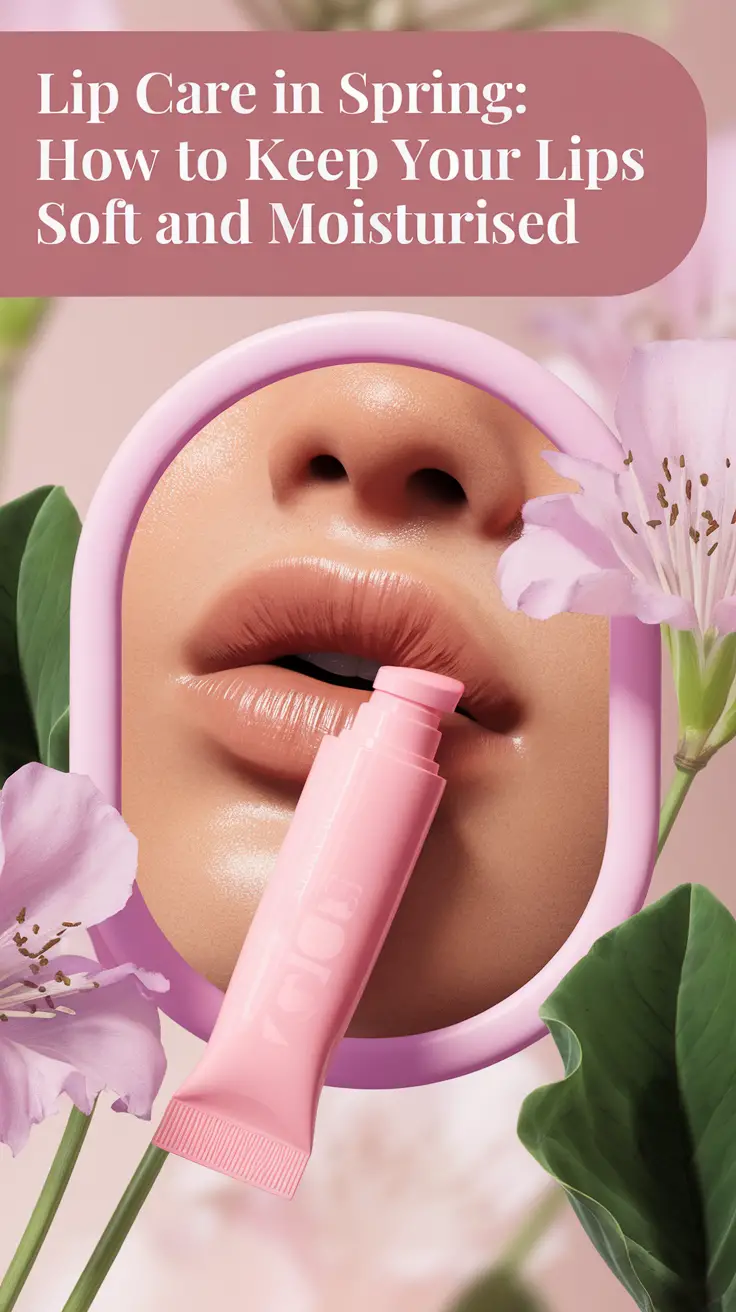
The Essential Lip Care Routine
1. Exfoliation: Renewing and Revitalizing
Exfoliating removes flaky, dead skin cells, allowing lip balms to penetrate more effectively. I recommend doing this gently 1-2 times a week to avoid irritation.
DIY Exfoliation Recipe
| Ingredient | Measurement | Purpose |
|---|---|---|
| Sugar (fine) | 1 teaspoon | Gently exfoliates |
| Honey | 1 teaspoon | Soothes and moisturizes |
| Olive oil | A few drops | Adds hydration and softness |
Mix these ingredients and massage them onto your lips in circular motions. Rinse off with warm water and pat dry.
2. Hydration: The Cornerstone of Lip Care
Moisturizing your lips is essential, as they lack oil glands. Choose a balm with nourishing ingredients like shea butter, beeswax, or hyaluronic acid. Reapply frequently, especially after eating or exposure to wind.
Best Lip Balms for Spring
| Product Name | Key Ingredients | Benefits |
|---|---|---|
| Sugar Advanced Therapy | Shea Butter, SPF 15 | Hydration and sun protection |
| Laneige Lip Sleeping Mask | Berry Extract | Overnight deep repair |
| Aquaphor Healing Ointment | Panthenol, Petrolatum | Restores severely dry lips |
3. Sun Protection: Shield Against Harmful Rays
Did you know that lips are one of the most sun-sensitive areas of your skin? Applying SPF lip balm prevents sunburn and discoloration. Always carry one with you during outdoor activities.
4. Break Bad Habits
Some habits, like licking or biting your lips, can cause more harm than good. Saliva dries out the lips quickly, and biting leads to cracks. Instead, reach for a hydrating balm whenever your lips feel dry.

Spring-Specific Challenges and Solutions
Managing Allergy-Induced Dryness
Spring allergies can cause frequent nose wiping, leading to irritation around your lips. To combat this:
- Use hypoallergenic, fragrance-free lip products.
- Apply a thin layer of petroleum jelly to create a protective barrier.
Dealing with Windy Days
Wind can strip moisture from your lips, so layering an occlusive balm over a hydrating one can lock in moisture and protect against the elements.
Nutrition for Naturally Soft Lips
Hydration starts from within! Include these nutrient-rich foods in your diet for naturally healthy lips:
- Vitamin E: Found in almonds and spinach, it aids in repairing skin cells.
- Omega-3 Fatty Acids: Salmon and flaxseeds help maintain moisture.
- Hydrating Foods: Cucumbers and watermelon keep your skin (and lips) hydrated.
DIY Lip Care Remedies
Natural remedies can be effective and budget-friendly. Here’s another easy-to-make mask for extra hydration:
DIY Aloe Vera Lip Mask
| Ingredient | Purpose |
|---|---|
| Aloe Vera Gel | Soothes and hydrates |
| Coconut Oil | Locks in moisture |
Mix equal parts aloe vera gel and coconut oil. Apply before bed and leave it on overnight.
Practical Tips for Outdoor Activities
- Always carry an SPF lip balm for reapplication.
- Wear a scarf or mask on windy days for extra protection.
- Avoid licking your lips during outdoor activities to minimize dryness.

Emergency Lip Repair Tips
If your lips are already chapped or cracked:
- Apply a thick layer of medical-grade lanolin for immediate hydration.
- Use a lip sleeping mask overnight for intensive repair.
- Avoid exfoliation until your lips heal completely.
FAQs: Your Lip Care Questions Answered
1. How often should I exfoliate my lips?
Once or twice a week is enough to remove dead skin cells without causing irritation.
2. Is SPF necessary for lip care in spring?
Absolutely! Lips are prone to sun damage, and an SPF balm prevents burns and discoloration.
3. What ingredients should I look for in a lip balm?
Shea butter, beeswax, hyaluronic acid, and SPF are excellent choices for hydration and protection.
4. Can I use my winter lip balm in spring?
You can, but switching to a lighter, hydrating formula suited to spring’s milder weather is better.
5. What foods can improve lip health?
Vitamin E (almonds), Omega-3s (salmon), and hydrating foods (cucumber) all contribute to softer, healthier lips.
Conclusion
Spring is the time to rejuvenate your lips and protect them from new seasonal challenges. By exfoliating regularly, hydrating with nourishing balms, protecting against the sun, and addressing allergies, you can keep your lips looking and feeling their best. Don’t forget, proper care and a balanced diet are key to achieving soft, healthy lips. Start today, and let your lips bloom as beautifully as the season!
Blog
Spring Skincare Trends 2025: Your Ultimate Guide to Radiant Skin
Spring is here, and it’s the perfect season to rejuvenate and refresh your skincare routine. As temperatures rise and the air becomes more humid, our skin needs tailored care to stay balanced and healthy. This year, skincare is all about innovation, sustainability, and embracing what works for your unique skin. Let’s dive into the most exciting spring skincare trends of 2025, from advanced technology to eco-friendly beauty solutions.
Personalized Skincare: Tailored to You
Personalized skincare has transformed how we care for our skin. With AI-powered tools and cutting-edge diagnostics, products are now designed specifically for your skin’s needs, taking into account factors like hydration levels, oil production, and even stress. This trend allows you to achieve visible results faster and more effectively.

Benefits of Personalized Skincare
- Customized Formulations: Products that match your skin type and goals.
- Targeted Results: Addressing specific issues like acne, redness, or fine lines.
- Time-Saving: Eliminates trial-and-error by using what works best.
| Traditional Skincare | Personalized Skincare |
|---|---|
| Generalized formulations | Tailored to individual needs |
| May cause irritation | Reduced risk of side effects |
| Requires multiple products | Multifunctional solutions |
Tip:
Try AI-driven apps or consultations at skincare clinics to create a tailored regimen.
Sustainability in Skincare
Eco-friendly and ethical beauty products are no longer just an option—they’re a necessity. Brands are stepping up with recyclable packaging, cruelty-free formulations, and clean ingredients that align with a greener planet.
Key Features
- Biodegradable Packaging: Reduces environmental impact.
- Cruelty-Free Testing: Ethical practices ensure no harm to animals.
- Natural Formulations: Avoid harsh chemicals and promote skin health.
Practical Tips
- Look for certifications like “EcoCert” or “Leaping Bunny” on packaging.
- Support brands that offer refillable options or zero-waste initiatives.
| Feature | Example |
|---|---|
| Recyclable Packaging | Glass jars, compostable bags |
| Cruelty-Free Certification | Leaping Bunny, PETA-approved |
| Vegan Ingredients | Plant-based alternatives |
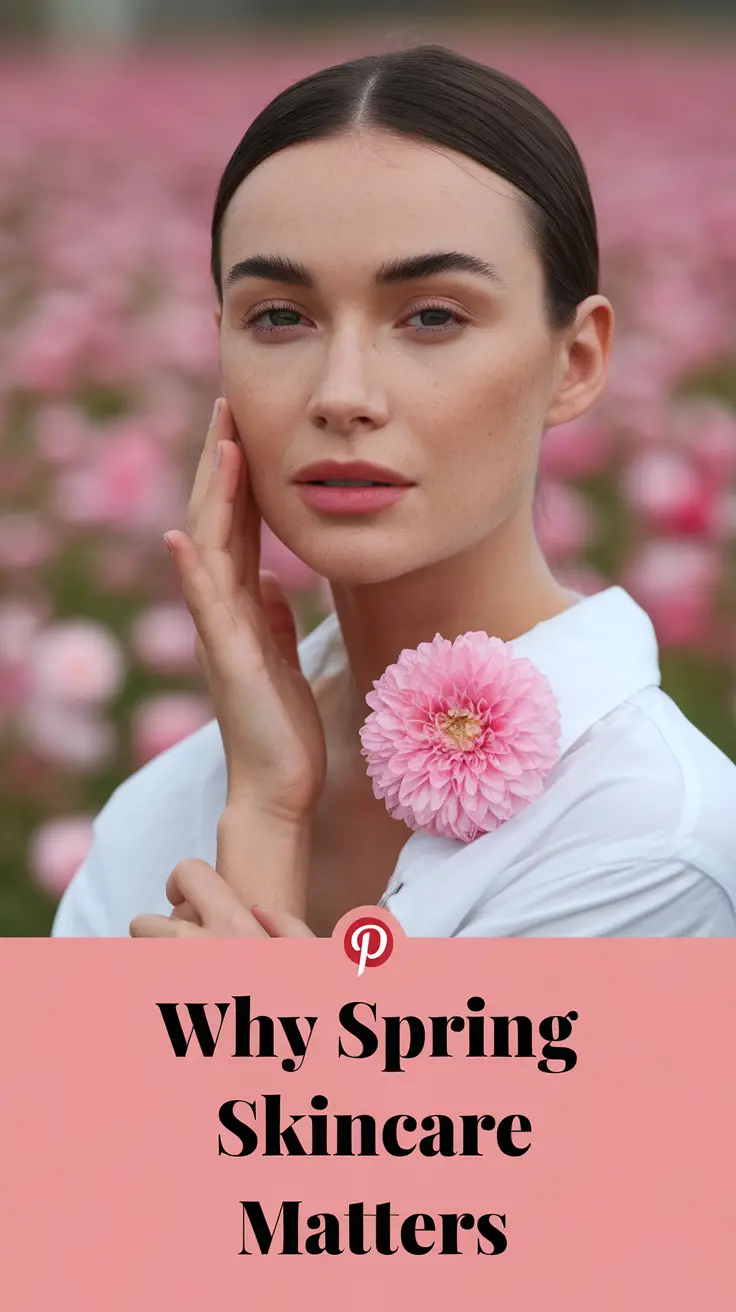
Biotech Ingredients: The Future of Skincare
The rise of biotech in skincare has introduced potent ingredients like bio-retinol and peptides. These ingredients provide all the benefits of traditional products without irritation, making them perfect for sensitive skin types.
Trending Biotech Ingredients
- Bio-Retinol: Anti-aging without dryness or peeling.
- Exosomes: Boost cell repair and collagen production.
- Peptides: Improve elasticity and reduce fine lines.
Checklist for Biotech Skincare
- Patch-test new ingredients.
- Gradually incorporate them into your routine.
- Monitor results for visible improvements.
Skinimalism: Simplify Your Routine
Minimalism meets skincare with “skinimalism,” a trend focused on fewer products and more effective results. This approach emphasizes natural beauty, reducing the risk of irritation from overloading your skin.
The Essentials for Skinimalism
- Gentle Cleanser: Removes dirt without stripping moisture.
- Hydrating Serum: Plumps and refreshes.
- Lightweight SPF: Essential for protection in spring.
| Old Routine | Skinimalism Routine |
|---|---|
| 5-7 steps daily | 3-4 multifunctional products |
| Time-consuming | Quick and efficient |
| Higher chance of irritation | Reduced risk |
Pro Tip:
Focus on high-quality, multifunctional products to streamline your routine.
Seasonal Adjustments for Spring
Spring’s warmer weather and increased allergens call for adjustments to your skincare routine. Transitioning from heavier winter products to lightweight formulations is key.
Tips for Spring Skincare
- Switch to Gel-Based Products: Perfect for managing humidity without clogging pores.
- Hydrate Wisely: Use mists to keep your skin fresh throughout the day.
- Protect Against Sunlight: A broad-spectrum SPF 30+ is non-negotiable.
Combat Pollen Allergies
- Use calming ingredients like chamomile and aloe vera.
- Cleanse twice daily to remove allergens from your skin.
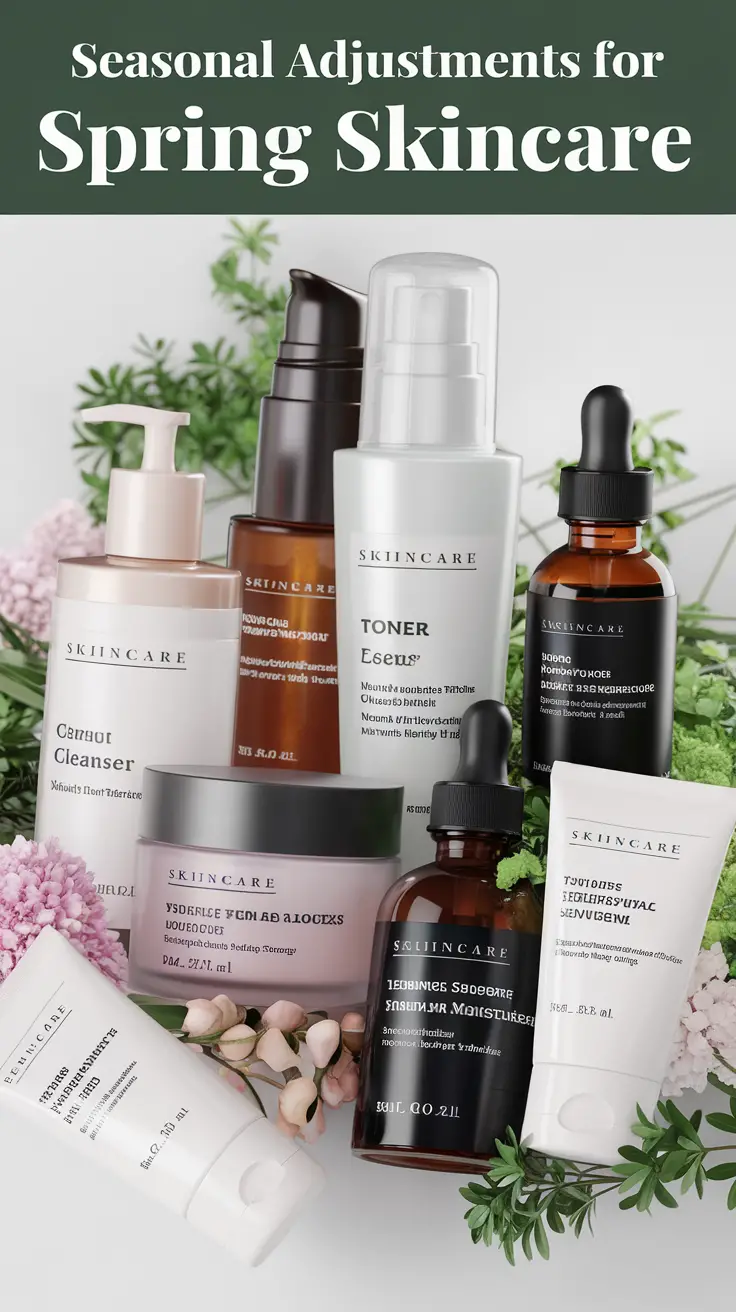
Tech-Integrated Skincare
Smart devices are changing how we approach skincare. AI-powered tools analyze your skin, while LED therapy masks offer at-home treatments that were once reserved for dermatologists.
Must-Have Devices
- AI Beauty Mirrors: Analyze skin and suggest routines.
- At-Home LED Masks: Stimulate collagen and calm inflammation.
- Smart Apps: Track skin changes over time.
Tip:
Invest in tools that align with your skincare goals, such as anti-aging or hydration-focused devices.
Wellness-Infused Beauty
Skincare now goes beyond the surface, incorporating wellness elements like adaptogens and CBD to target stress-induced skin issues.
Key Wellness Ingredients
- Adaptogens: Combat oxidative stress and support skin repair.
- CBD: Soothes inflammation and redness.
- Aromatherapy Oils: Promote relaxation while nourishing your skin.
Pro Tip:
Incorporate wellness products into your nighttime routine for maximum benefits.
Conclusion
Spring 2025 is a season of transformation, not only for nature but also for skincare. By embracing personalized routines, eco-conscious choices, and advanced technologies, you can achieve glowing, healthy skin tailored to your needs. Remember, skincare isn’t one-size-fits-all—experiment, adjust, and listen to your skin’s unique needs.
FAQs
- What’s the best SPF for spring?
Opt for lightweight, non-comedogenic formulas with SPF 30 or higher. - How do I transition my routine for spring?
Swap heavy moisturizers for gel-based options and include hydrating mists. - Are biotech ingredients safe for beginners?
Yes, but start slow and monitor your skin’s reaction. - How can I manage pollen-related skin irritation?
Use calming products with aloe vera or niacinamide. - What’s the simplest way to embrace sustainability?
Choose refillable products or those with eco-friendly packaging.
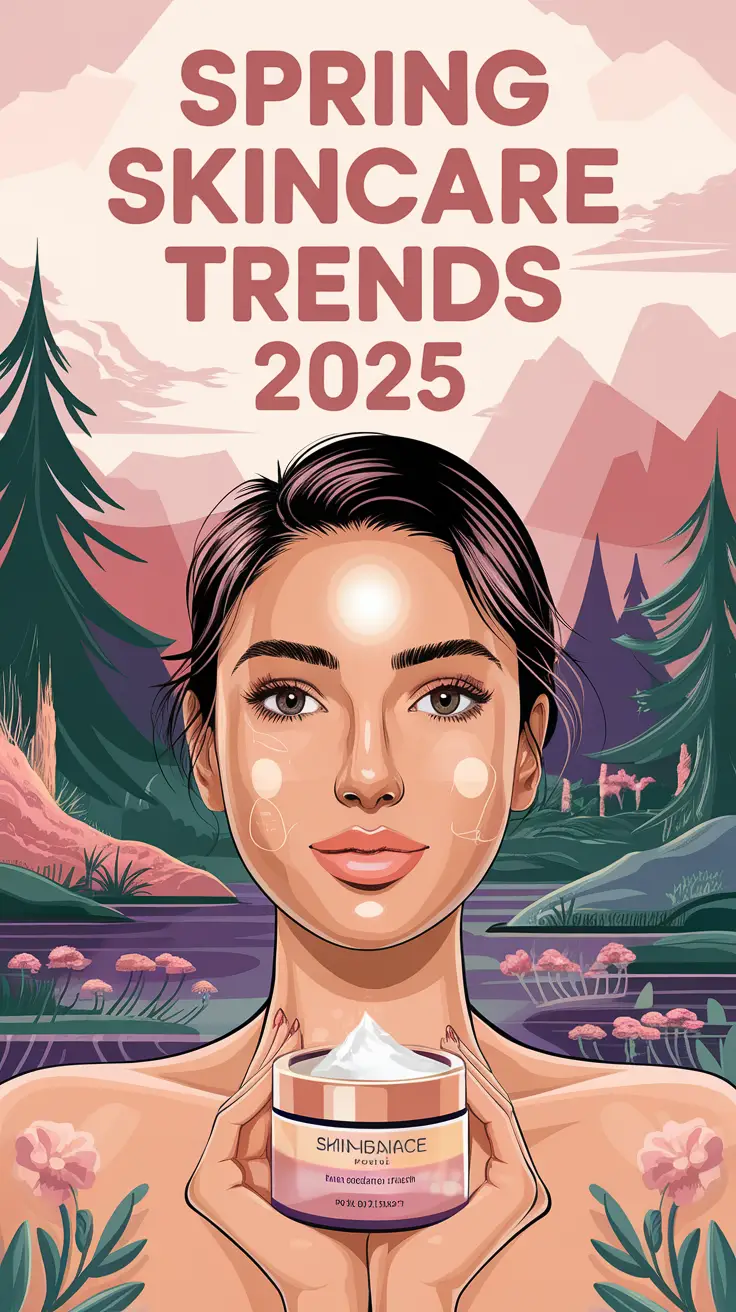
Blog
The Best Spring Skincare Routine for All Skin Types
As spring approaches, our skin undergoes a significant transformation. The chilly, dry air of winter gives way to humidity, sunlight, and increased outdoor activity. To keep your skin glowing and healthy, transitioning to a tailored spring skincare routine is essential. On my journey to achieving radiant skin, I’ve found that understanding your unique skin type is the key to unlocking the best results. Let’s dive into how you can adapt your routine for spring’s challenges!
Why Spring Skincare Needs Special Attention
Spring is a season of renewal for both nature and our skin. During winter, our skin often becomes dry and sensitive due to low humidity and indoor heating. Spring, however, brings pollen, higher temperatures, and increased sun exposure, all of which can influence our skin’s behavior.
On top of that, the skincare products that worked wonders during winter might no longer suit your spring needs. For instance, heavy moisturizers may clog pores in humid weather, while lighter products may lack the hydration needed for lingering dryness. By adjusting your skincare, you can prepare your skin to thrive in this season of change.
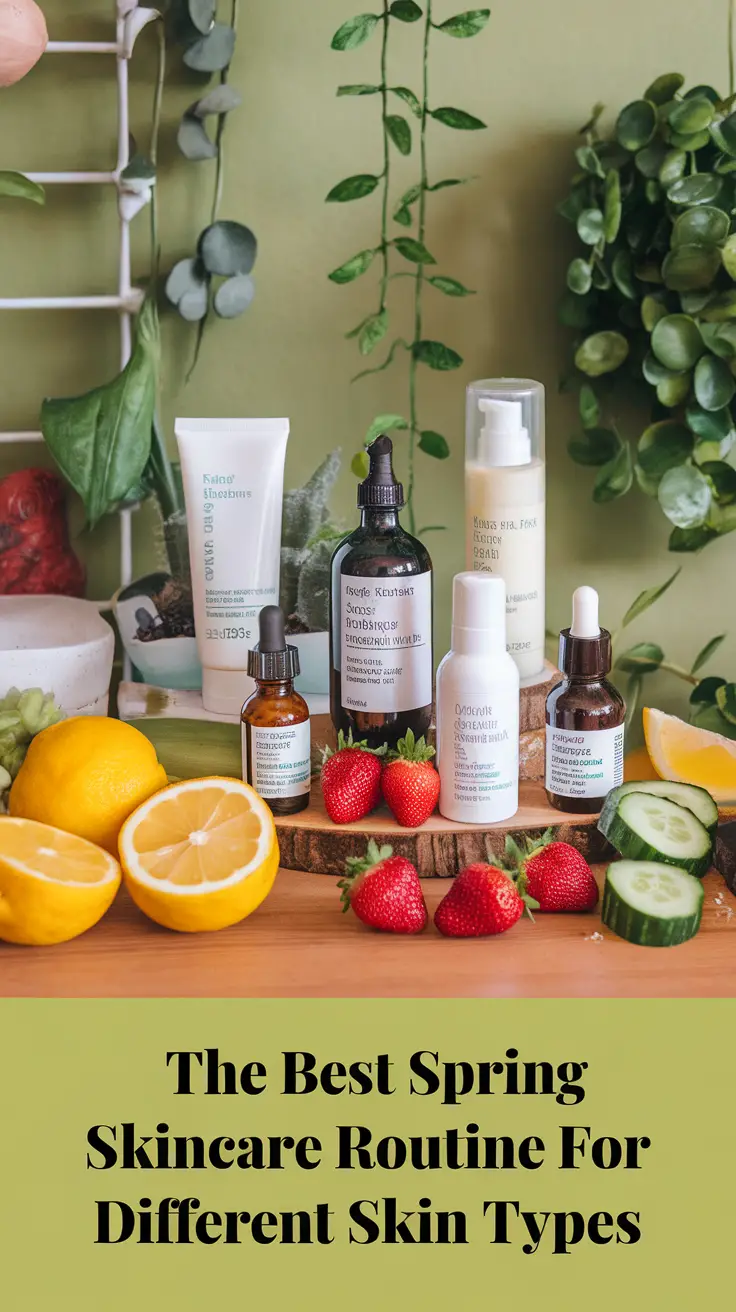
Identify Your Skin Type
Before curating your spring skincare routine, it’s crucial to understand your skin type. Here’s a quick overview to help:
| Skin Type | Characteristics |
|---|---|
| Normal Skin | Balanced, rarely breaks out, and feels neither too dry nor oily. |
| Dry Skin | Tight, flaky, or dull, especially during seasonal transitions. |
| Oily Skin | Shiny appearance, enlarged pores, and prone to acne. |
| Combination Skin | Oily in the T-zone (forehead, nose, chin) and normal or dry elsewhere. |
| Sensitive Skin | Redness, irritation, or reactions to weather, products, or environmental changes. |
Spring Skincare Routines Tailored to Skin Types
1. Dry Skin Routine
Spring might bring relief from winter dryness, but dry skin still needs extra hydration.
Morning Routine:
- Cleanser: A creamy, hydrating cleanser enriched with ceramides.
- Toner: Alcohol-free toner with rose water or glycerin.
- Serum: Hyaluronic acid serum to boost hydration.
- Moisturizer: A rich, nourishing cream that locks in moisture.
- Sunscreen: A moisturizing SPF 30+ for hydration and protection.
Evening Routine:
- Cleanser: Repeat the hydrating cleanser.
- Exfoliation: Use a gentle exfoliant twice a week to remove dead skin.
- Serum: Add peptides or ceramides for skin repair.
- Moisturizer: A thick night cream or sleeping mask for deep hydration.
2. Oily Skin Routine
Spring’s humidity can exacerbate oil production, making lightweight products essential.
| Step | Product Recommendations |
|---|---|
| Cleanser (Morning) | Gel-based or salicylic acid cleanser to control sebum. |
| Toner | Witch hazel or niacinamide-based toner. |
| Serum | Lightweight serum with niacinamide or zinc to regulate oil production. |
| Moisturizer | Oil-free, mattifying moisturizer. |
| Sunscreen | Non-comedogenic, broad-spectrum SPF 30+. |
Evening Routine:
- Repeat the cleanser and toner.
- Exfoliate 2–3 times weekly with a BHA exfoliant.
- Use a retinol treatment to reduce oil production.
- Finish with a gel-based moisturizer.
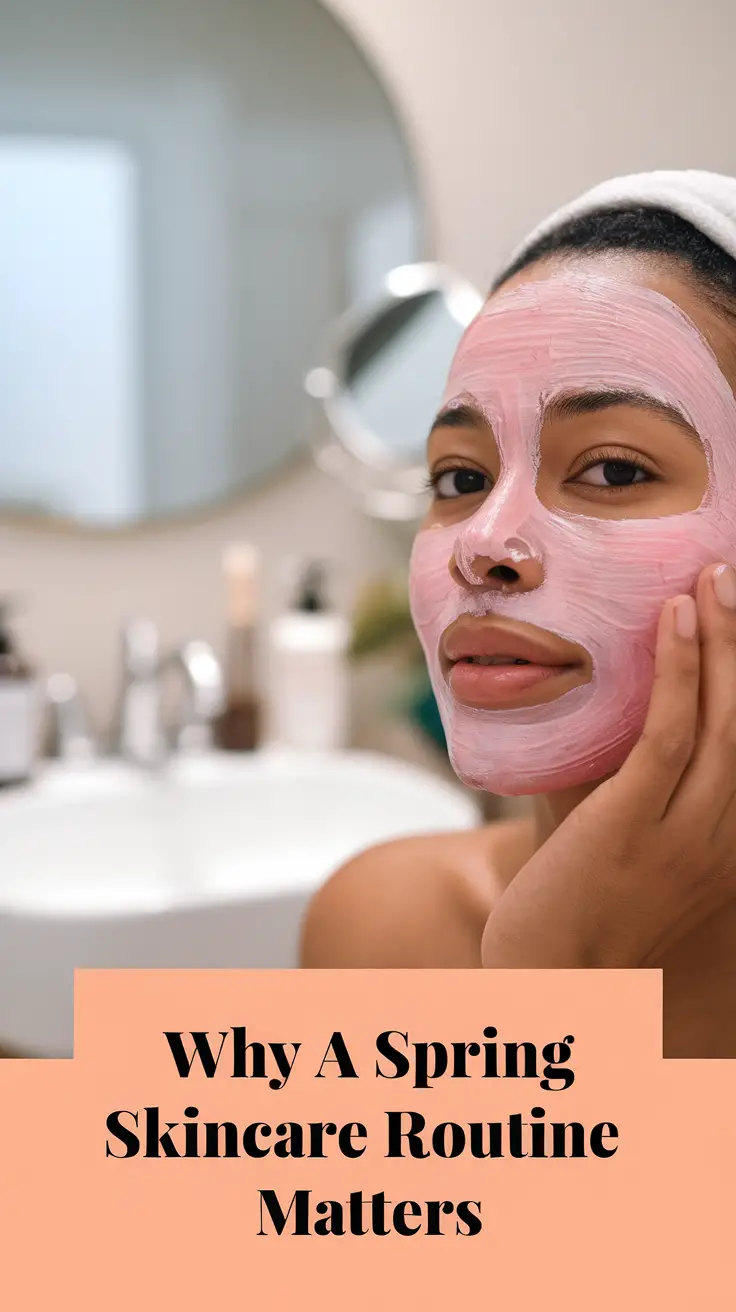
3. Combination Skin Routine
Balancing hydration and oil control is the goal for combination skin.
Morning Routine:
- Cleanser: Use a gentle foaming cleanser.
- Toner: A balancing toner to hydrate dry areas and manage oil.
- Serum: Vitamin C serum for brightness and even skin tone.
- Moisturizer: Apply lightweight moisturizer where needed.
- Sunscreen: Choose a broad-spectrum sunscreen that suits combination skin.
Evening Routine:
- Exfoliation: Use a mild exfoliant once or twice a week.
- Treatment: Apply acne spot treatment on oily areas if needed.
- Moisturizer: A lightweight night cream that won’t clog pores.
4. Sensitive Skin Routine
For sensitive skin, simplicity and gentle products are non-negotiable.
Morning Routine:
- Cleanser: A fragrance-free, soothing cleanser.
- Toner: Aloe vera or chamomile-based toner for calming effects.
- Serum: Hyaluronic acid serum with minimal ingredients.
- Moisturizer: Hypoallergenic, calming moisturizer.
- Sunscreen: Mineral-based SPF to minimize irritation.
Evening Routine:
- Exfoliation: Limit to once a week with a gentle scrub or enzyme-based exfoliant.
- Treatment: Niacinamide-based products to reduce redness.
- Moisturizer: Apply a reparative night cream.
Additional Spring Skincare Tips
- Hydration Matters: Drink at least 2 liters of water daily for glowing skin.
- Sun Protection: Reapply sunscreen every two hours when outdoors.
- Seasonal Treatments: Try clay masks for detox or hydration masks to replenish moisture.
- Diet: Include antioxidant-rich foods like berries and leafy greens to fight free radicals.
FAQs
1. How often should I exfoliate in spring?
Exfoliate 1–2 times per week, depending on your skin’s sensitivity and needs.
2. What’s the best sunscreen for spring?
Opt for a broad-spectrum SPF 30+ suited to your skin type. Look for lightweight, non-comedogenic formulas for oily or combination skin.
3. Can I use my winter moisturizer in spring?
Transition to a lighter moisturizer unless your skin remains very dry.
4. How do I prevent spring allergies from affecting my skin?
Wash your face frequently, avoid touching your face, and use calming skincare products to minimize reactions.
5. Are natural remedies effective for spring skincare?
Yes! Green tea as a toner and aloe vera gel are great for soothing skin naturally.
Conclusion
Spring offers a fresh start for both your lifestyle and your skincare routine. By understanding your skin type and addressing seasonal challenges, you can create a routine that keeps your skin glowing all season long. Don’t wait—start transitioning your skincare today, and watch your skin blossom along with the season!

-

 Hairstyle7 months ago
Hairstyle7 months agoRound Face Haircuts Ideas 2025: 29 Flattering Styles to Try
-

 Hairstyle7 months ago
Hairstyle7 months ago25 90s Layered Hair Ideas to Inspire Your 2025 Look
-

 Fashion6 months ago
Fashion6 months ago27 Every Day Spring Outfits Inspiration for 2025
-

 Hairstyle7 months ago
Hairstyle7 months ago29 Long Layered Haircuts Ideas for 2025
-

 Hairstyle11 months ago
Hairstyle11 months ago64 Fall Hair Color Trends to Elevate Your Style in 2024
-

 Hairstyle8 months ago
Hairstyle8 months agoChoppy Bob Haircuts 2025: 29 Stylish Ideas
-

 Hairstyle7 months ago
Hairstyle7 months ago27 Medium Length Haircut with Layers Ideas for 2025
-

 Hairstyle9 months ago
Hairstyle9 months ago25 Winter Haircuts Ideas for 2024-2025 to Refresh Your Look
